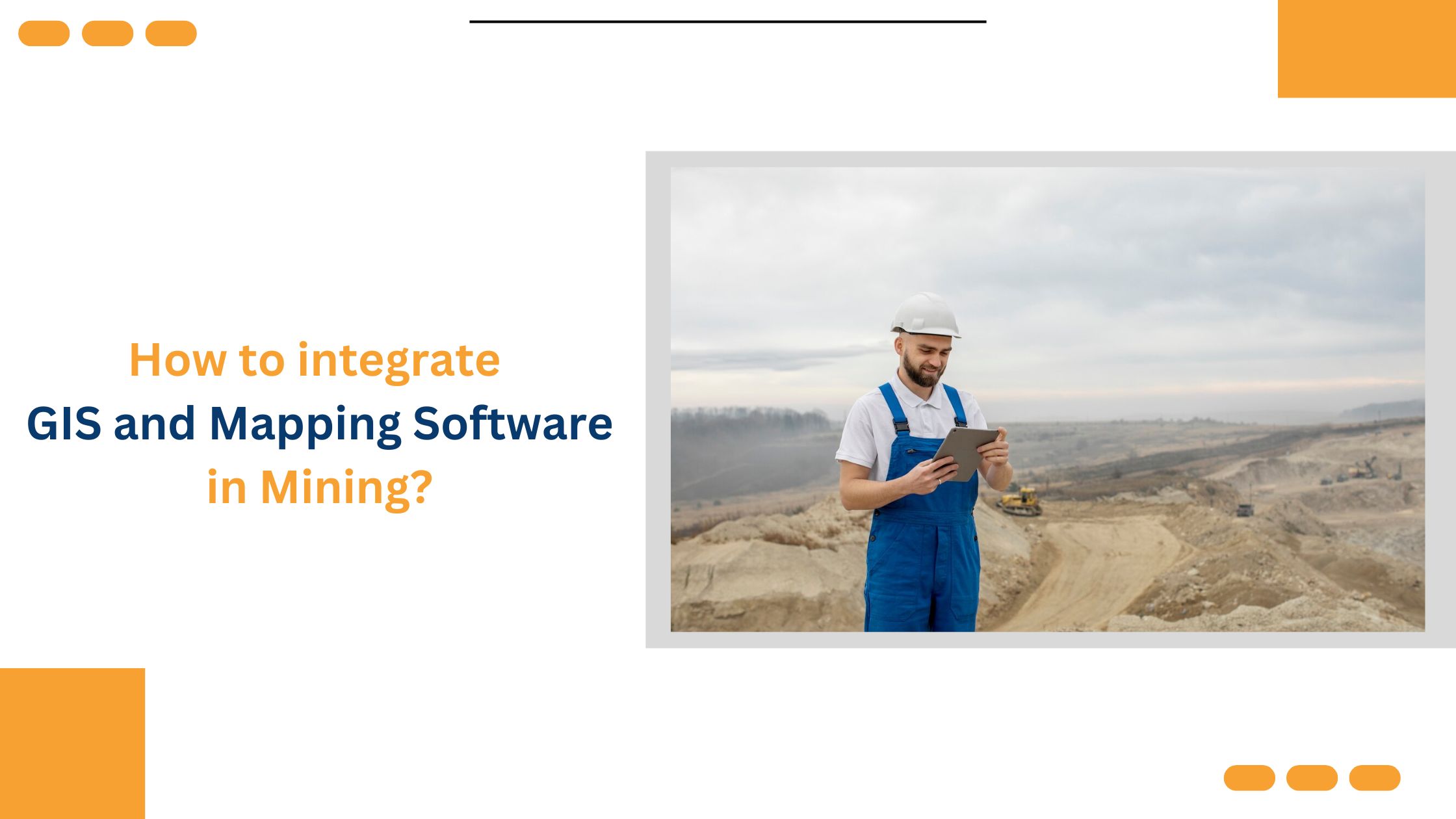
We use cookies and similar technologies that are necessary to operate the website. Additional cookies are used to perform analysis of website usage. please read our Privacy Policy
How to integrate GIS and Mapping Software in Mining?

Mining is a complex industry that relies heavily on accurate information about where things are located underground and above ground. That’s where GIS (Geographic Information Systems) and mapping software come in. These tools help mining companies make better decisions about where to dig, how to manage resources, and how to keep workers safe.
In this blog, we’ll explore why integrating GIS and mapping software into mining operations is so important. We’ll break down the benefits it brings, the challenges companies might face, and the steps they can take to make integration successful.
Understanding GIS and Mapping Software
GIS stands for Geographic Information System. It’s a powerful tool that helps us capture, store, analyze, and display geographical data. Imagine it as a smart map that not only shows locations but also provides detailed information about those places. Here are the main components of GIS:
- Hardware: The physical devices like computers and GPS units.
- Software: The programs used to process and analyze the data.
- Data: The geographical information collected from various sources.
- People: The experts who operate the system and analyze the data.
- Methods: The techniques and procedures used to analyze and interpret the data.
Mapping software works hand-in-hand with GIS to make sense of geographical data. Here are some key features:
- Data Visualization: Creates detailed maps and 3D models.
- Spatial Analysis: Helps in understanding patterns and relationships in the data.
- Data Management: Organizes and stores large amounts of geographical information.
- Integration: Can work with other software and tools for more comprehensive analysis.
- User-Friendly Interfaces: Easy to use, even for those who aren’t tech-savvy.
Benefits of Integrating GIS and Mapping Software in Mining
By leveraging the power of GIS and mapping software, mining operations can become more efficient, safer, and more cost-effective, leading to better outcomes for both the company and the environment.
1. Improved Spatial Analysis
Integrating GIS (Geographic Information Systems) and mapping software in mining industry allows for better spatial analysis. This means you can visualize and analyze the geography of mining sites more accurately. You can create detailed maps showing mineral deposits, geological features, and other important data. This helps in making informed decisions about where to mine and how to manage the land.
2. Enhanced Resource Management
With GIS and mapping software, managing resources becomes more efficient. You can track the location and quantity of minerals, monitor the environmental impact, and optimize the use of resources. This leads to more sustainable mining practices, reducing waste and ensuring that resources are used effectively.
3. Streamlined Exploration and Planning Processes
GIS and mapping software simplify the exploration and planning processes. By providing detailed maps and data, these tools help identify potential mining sites faster. They also assist in planning the layout of mining operations, including roads, facilities, and safety zones. This reduces the time and effort needed for exploration and planning, making the whole process more efficient.
4. Increased Safety Measures
Safety is a top priority in mining, and GIS and mapping software play a crucial role in enhancing it. These tools can map out hazardous areas, monitor environmental conditions, and predict potential risks. By having access to accurate and up-to-date information, mining companies can implement better safety measures, protecting workers and reducing the risk of accidents.
5. Cost Reduction and Time Efficiency
Integrating GIS and mapping software helps reduce costs and save time. Accurate data and efficient planning minimize the risk of costly mistakes. Simplifying processes means that less time is spent on exploration and planning and more time is devoted to actual mining. Additionally, better resource management and enhanced safety measures contribute to overall cost savings.
Steps to Integrate GIS and Mapping Software in Mining
Integrating GIS and mapping software into your mining operations can be hard to deal with, but breaking it down into clear steps makes the process manageable and effective. Here’s a simple guide to help you through the integration:
1. Assessing Current Systems and Needs
First, take a close look at your current systems and processes. Understand what tools you’re currently using and identify any gaps or inefficiencies. Determine your specific needs and goals for integrating GIS and mapping software. This will help you choose the right solutions and ensure a smoother integration process.
2. Choosing the Right Software Solutions
Next, research and select the software that best fits your needs. There are many GIS and mapping software options available, each with different features and capabilities. Consider factors like ease of use, compatibility with your existing systems, and the specific needs of your mining operations. Make sure to choose software that will grow with your business and offer robust support and updates.
3. Data Standardization and Integration
Once you’ve chosen your software, the next step is to standardize and integrate your data. This means ensuring that all your data is in a compatible format and can be easily used by the new software. Clean and organize your data to avoid any issues during integration. This step is crucial for accurate analysis and reporting.
4. Training and Education for Staff
Your team needs to be comfortable and proficient with the new software. Provide complete training and educational resources to ensure everyone understands how to use the new tools effectively. Ongoing training is also important to keep up with updates and new features.
5. Implementing Best Practices for Integration
Finally, adopt best practices to ensure a successful integration. This includes regular monitoring and maintenance of the system, staying updated with the latest software versions, and continuously seeking feedback from your team to make improvements. Create a plan for troubleshooting and resolving any issues that may arise during and after the integration process.
Challenges and Solutions in Integrating GIS and Mapping Software in Mining
1. Data Integration Challenges
When integrating GIS and mapping software, one of the biggest challenges is combining data from different sources. Mining operations often have data in various formats, such as maps, spreadsheets, and reports. Ensuring all this information can work together seamlessly in a single system is critical but tricky.
Solutions include:
- Standardizing Data Formats: Converting all data into compatible formats.
- Using Middleware: Employing software that helps different systems communicate.
B. Software Compatibility Issues
Different software programs might not always work well together, causing compatibility issues. For example, the mapping software might not sync properly with GIS tools.
To tackle this problem:
- Choosing Compatible Software: Select programs designed to integrate easily.
- Regular Updates: Keeping all software up-to-date to ensure they work well together.
C. Training and Skill Development
Introducing new technology means that staff will need to learn how to use it. This can be both time-consuming and costly.
Solutions to this challenge include:
- Comprehensive Training Programs: Offering extensive training sessions for staff.
- Ongoing Support: Providing continuous help and resources as staff get accustomed to new tools.
D. Overcoming Regulatory Hurdles
Mining is a heavily regulated industry, and ensuring compliance with various laws and regulations when integrating new technology is essential. Overcoming this involves:
- Staying Informed: Keeping up-to-date with current laws and regulations.
- Working with Experts: Consulting with legal and regulatory experts to ensure compliance.
Conclusion
Integrating GIS and mapping software in mining operations is crucial for maximizing efficiency and ensuring sustainable practices. By partnering with a reputable mining industry software development company, mining companies can simplify their processes, enhance safety measures, and reduce costs. Embracing this integration not only improves operational efficiency but also contributes to responsible resource management and environmental stewardship.
As technology continues to advance, the future of mining lies in harnessing the power of GIS and mapping software to drive innovation and meet the evolving needs of the industry. Let’s work together towards a future where mining operations are not only productive but also environmentally conscious and socially responsible.
We are here
Our team is always eager to know what you are looking for. Drop them a Hi!
Zealous Team
Meet the Zealous Team – your dedicated source for cutting-edge insights on the latest technologies, digital transformation, and industry trends. With a passion for innovation and a commitment to delivering unparalleled expertise.
Table of Contents
×

Comments